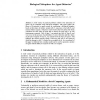Free Online Productivity Tools
i2Speak
i2Symbol
i2OCR
iTex2Img
iWeb2Print
iWeb2Shot
i2Type
iPdf2Split
iPdf2Merge
i2Bopomofo
i2Arabic
i2Style
i2Image
i2PDF
iLatex2Rtf
Sci2ools
ISCIS
2004
Springer
2004
Springer
Biological Metaphors for Agent Behavior
A wide variety of practical problems related to the interaction of agents can be examined using biological metaphors. This paper applies the theory of G-networks to agent systems by considering a biological metaphor based on three types of entities: normal cells C, cancerous or bad cells B, and immune defense agents A which are used to destroy the bad cells B, but which sometimes have the effect of being able to destroy the good cells C as well (autoimmune response). Cells of type C can mutate into cells of Type B, and vice-versa. In the presence of probabilities of correct detection and false alarm on the part of agents of Type A, we examine how the dose of agent A will influence the desired outcome which is that most bad cells B are destroyed while the damage to cells C is limited to an acceptable level. In a second part of the paper we illustrate how a similar model can be used to represent a mixture of agents with the ability to cooperate as well as to compete.
| Added | 02 Jul 2010 |
| Updated | 02 Jul 2010 |
| Type | Conference |
| Year | 2004 |
| Where | ISCIS |
| Authors | Erol Gelenbe, Varol Kaptan, Yu Wang |
Comments (0)

